
This commemorative day predates Christianity, with pagan festivals being held in European countries to celebrate the winter solstice. The Yule celebrations (North European paganism) and the month-long festivities of Saturnalia (for Saturn, the Roman god of agriculture) were gradually merged with Christmas celebrations.
Many of the traditions associated with Christmas are of pagan origin, including Christmas trees, the burning of the Yule log, the hanging of mistletoe, putting up wreaths of holly, the giving of presents at the end of December, door-to-door caroling (wassailing), and Father Christmas (believed to be derived from Saint Nicholas as Santa Claus, via Odin and Sleipnir of the Norse religion).
Therefore, taking into account its origins, Christmas Day can be widely celebrated, whether one is of the Christian faith or not.
Christmas time in Australia is normally very hot, in contradistinction to the cold and snowy Christmases which the founders of the British colonies in Australia were used to. Australian celebrations of Christmas normally include barbeques, picnics, or other gatherings under the hot summer sun, creating a new style of Christmas down under.
The Christmas experience of Australians has normally been coloured by the Christmas ethos of Europe, with Christmas cards and Christmas wrapping paper depicting snowy themes, along with Santa Claus in his warm red suit. However, for many decades, Australians have been incorporating Australian fauna and flora into their Christmas decorations. Modern depictions of Santa in Australia often show him wearing shorts in Australian settings (thereby Australianising the European concept of Father Christmas).
Although Christmas has traditionally been seen through a European lens, Australians have long been developing their own style of celebrating this end-of-year event.
Articles, poems, and stories regarding Christmas:
(Arranged in chronological order.)
[Christmas-Day, 1854!] [25 December 1854]
An untitled article, which compares Christmas in Australia to Christmas in England.
Christmas in Australia [poem, 25 December 1875]
A poem regarding Christmas.
A Christmas Welcome [poem, 21 December 1878]
A poem about Christmas, by “R.A.”
Christmas Morn [poem by R. G. S. (John Neilson, senior), 25 December 1878]
A poem about Christmas, by “R.G.S.” (a pseudonym of John Neilson, 1844-1922).
Inseparables [17 December 1887]
A “Stray notes” article which talks of Christmas in England, but which concludes with the thought that most in Australia would prefer to have Christmas down under (“probably not many of our boys would change the new world for the old”).
Christmas songs [17 December 1887]
A “Stray notes” article which talks of Christmas in England, but which concludes with the thought that it is good that Australians don’t have some of the English Christmas traditions (“Australians do not send out their young people, even in sport, to beg at Christmastide. We have no mummers, thank Providence.”).
Christmas music [17 December 1887]
A “Stray notes” article about Christmas music.
Christmas cold [17 December 1887]
A “Stray notes” article which talks about the heat in Brisbane, as well as the coldest Christmas in England, and concludes with the slogan “Australia for ever!”
Christmas games [17 December 1887]
A “Stray notes” article which talks about Christmas games, and says that Australians have no developed any Christmas-specific games, but rather indulge in games which are played all year round.
Australia’s Father Christmas [by Charles Rhoades, 12 December 1888]
A short story, by Charles Rhoades.
The Christmas Angel [poem by Mary Hannay Foott, 26 December 1891]
A Christmas poem, by Mary Hannay Foott (1846-1918).
The Governor’s Xmas Party [poem by W. T. Goodge, 25 December 1898]
A poem, by W. T. Goodge (1862-1909), about a Governor’s Christmas Party.
Best Wishes [postcard, early 20th Century]
A postcard, with a message for Christmas and New Year.
New Year greetings [postcard, early 20th Century]
A postcard, with a message for Christmas and New Year.
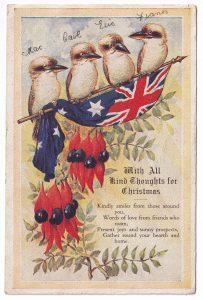
A patriotic Christmas postcard.
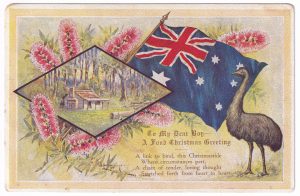
A patriotic Christmas postcard.
The Exiles [by Alice Grant Rosman, 3 January 1903]
An article, by Alice Grant Rosman, about old folk reminiscing about cold Christmases in Europe, whilst the Australian-born youngsters enjoy “the hot Australian Christmas Day”.
Christmas is Christmas still! [poem by Harold Mercer, 24 December 1903]
A Christmas poem, by Harold Mercer.
The Land of the Wallaby [postcard, 18 November 1910]
A postcard, with a message for Christmas and New Year.
Advance Australia [postcard, 20 December 1910]
A patriotic postcard, with a message for Christmas and New Year.
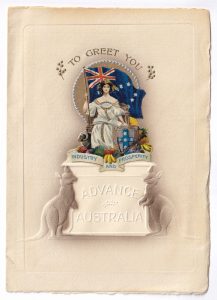
A patriotic Christmas card.
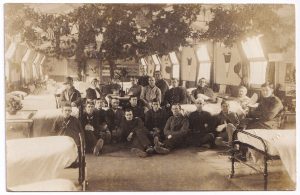
This undated postcard, which incorporates a photo of a group of wounded Australian soldiers in a hospital, taken around Christmas time, was sent by a soldier to his mother, during the era of the First World War (1914-1918).
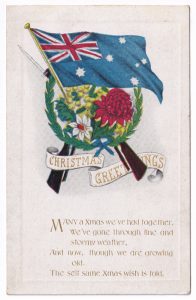
A patriotic Christmas postcard, with a message for Christmas and New Year, sent during the First World War (1914-1918).
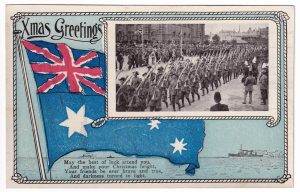
An unused patriotic Christmas postcard, from the era of the First World War (1914-1918).
A Christmas Greeting to K. B. [poem by Joseph Furphy, 1916]
A poem for Christmas, written for Kate Baker (1861-1953) by Joseph Furphy (1843-1912). Published posthumously in The Poems of Joseph Furphy (1916).
A Christmas Hymn [poem by Joseph Furphy, 1916]
A Christmas poem, written by Joseph Furphy (1843-1912). Published posthumously in The Poems of Joseph Furphy (1916).

A patriotic Christmas postcard, sent during the First World War (1914-1918).
Advance Australia [postcard, December 1917]
A patriotic postcard, posted for Christmas, sent during the First World War (1914-1918).
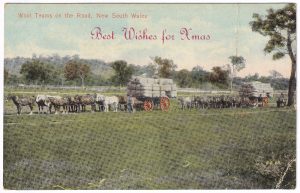
A postcard, with a message for Christmas and New Year.
The Christmas Vision [poem by L. E. Homfray, 17 December 1920]
A religious poem, regarding the birth of Christ, by L. E. Homfray (1873-1951).
Echoes of the Christmas Bells [poem by L. E. Homfray, 23 December 1921]
A poem for Christmas, by L. E. Homfray (1873-1951).
Christmas Camp [poem by “Dryblower” Murphy, 1926]
A Christmas poem, by “Dryblower” Murphy (1866-1939), written from the point of view of an ex-miner swagman.
Gore-dliness: A Christmas Carol [poem by “Dryblower” Murphy, 1926]
A poem, by “Dryblower” Murphy (1866-1939), about a boxing match held on Christmas Day.
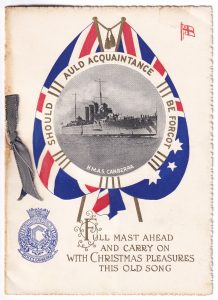
A naval Christmas card.
An appeal for our weaker brothers & sisters [letter from L. E. Homfray, 29 November 1929]
A letter, from L. E. Homfray (1873-1951), seeking donations of presents, or money, for the mentally disabled (for Christmas).
What Would You Like? [poem by L. E. Homfray, 21 December 1929]
A Christmas poem for children, by L. E. Homfray (1873-1951).
An Australian Father Christmas [poem, 23 December 1932]
A poem, by George White, which calls for the creation of Australian Christmas traditions, including an Australian Father Christmas.
Cousin Cassie’s Letter to Women [21 January 1937]
An article which marvels at the ingenuity of some new Christmas gifts.
It is great to see a collection of articles and pictures about Christmas in an Australian context.
Our summery Christmas is very different to the wintery Christmas in the cold northern hemisphere.
I think it was back in the 1980s that a wave of Aussie Christmas publications came out. There were lots of postcards with pictures of Santa in Australia, wearing red shorts, or of pictures him wearing board shorts and going surfing, with some Aussie animals nearby. There was also the book ‘The Australian Twelve days of Christmas’ by Michael Salmon, which was great for kids.
We need more stuff like that.
Please don’t use AI. The aesthetic is very cheap and does not reflect the authenticity of your archive.
Maybe you got it off google. The Koala in Santa clobber is defo Ai
The koala picture is definitely AI-created; in fact the file name of the image specifies that it is AI: “ChristmasKoalaAIArt500x500” (the term “AI Art” is the relevant part). The image was specifically created for this site.
To date, AI art has been used on 11 posts on this site (out of 4928 posts), and each AI graphic is marked as such, so that everyone can know its creation status.
When there is a suitable quality graphic, preferably in colour, that can be used for posts, that path is normally taken, although sometimes that can be problematic as the copyright status of images can be hard to determine (copyright laws are a nightmare in Australia, as they are over-powered way past their social necessity, which can hamper the provision of historical services to the Australian nation).
Sometimes the creation of AI graphics can be quite useful. And they can also be very nice as well (although the quality of art can be a subjective matter, and beauty is in the eye of the beholder).
Therefore, there will be times when AI art is used on the site (and will be marked as such). However, it is expected that the vast majority of images on the site will be taken from historical sources.